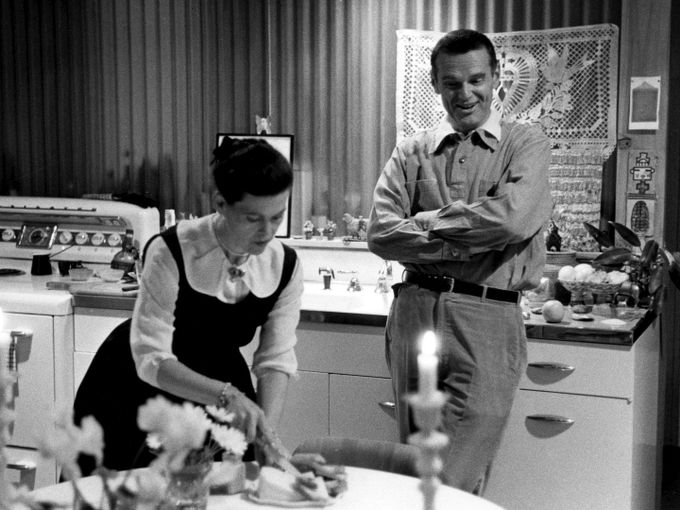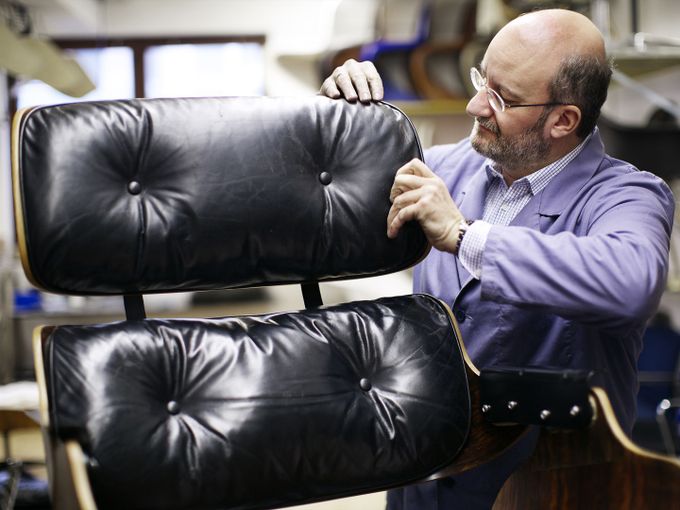What Is Your Definition of “Design,” Monsieur Eames?
A Vitra Anecdote

In 1969 Charles and Ray Eames were invited to participate in the exhibition ‘Qu’est ce que le design?’ at the Musée des Arts Décoratifs, Palais du Louvre, in Paris. The conceptual basis of the exhibition was a series of questions and answers on the topic of design.
The Eames Office showed a range of works for different clients, along with floor-to-ceiling photographic blow-ups of the museum’s questions and Charles Eames’ answers. Charles’ famous diagram illustrating the design process was also made for this exhibition.
The Eames Office showed a range of works for different clients, along with floor-to-ceiling photographic blow-ups of the museum’s questions and Charles Eames’ answers. Charles’ famous diagram illustrating the design process was also made for this exhibition.


The script was later used for a film made by Charles and Ray Eames in 1972 with the title Design Q and A. In the film, the questions and answers are read aloud and accompanied by a selection of the Eameses’ own photographs.
The questions and answers are printed below with pictures selected by the Eameses for the 1972 film.
Design Q & A
Questions by Madame L. Amic, answers by Charles Eames.
Q: What is your definition of ‘Design,’ Monsieur Eames?
A: One could describe Design as a plan for arranging elements to accomplish a particular purpose.
Q: Is Design an expression of art?
A: I would rather say it’s an expression of purpose. It may, if it is good enough, later be judged as art.
The questions and answers are printed below with pictures selected by the Eameses for the 1972 film.
Design Q & A
Questions by Madame L. Amic, answers by Charles Eames.
Q: What is your definition of ‘Design,’ Monsieur Eames?
A: One could describe Design as a plan for arranging elements to accomplish a particular purpose.
Q: Is Design an expression of art?
A: I would rather say it’s an expression of purpose. It may, if it is good enough, later be judged as art.


Q: Is Design a craft for industrial purposes?
A: No, but Design may be a solution to some industrial problems.
Q: What are the boundaries of Design?
A: What are the boundaries of problems?
Q: Is Design a discipline that concerns itself with only one part of the environment?
A: No.
Q: Is it a method of general expression?
A: No. It is a method of action.
Q: Is Design a creation of an individual?
A: No, because to be realistic, one must always recognize the influence of those that have gone before.
Q: Is Design a creation of a group?
A: Very often.
Q: Is there a Design ethic?
A: There are always Design constraints, and these often imply an ethic.
Q: Does Design imply the idea of products that are necessarily useful?
A: Yes, even though the use might be very subtle.
A: No, but Design may be a solution to some industrial problems.
Q: What are the boundaries of Design?
A: What are the boundaries of problems?
Q: Is Design a discipline that concerns itself with only one part of the environment?
A: No.
Q: Is it a method of general expression?
A: No. It is a method of action.
Q: Is Design a creation of an individual?
A: No, because to be realistic, one must always recognize the influence of those that have gone before.
Q: Is Design a creation of a group?
A: Very often.
Q: Is there a Design ethic?
A: There are always Design constraints, and these often imply an ethic.
Q: Does Design imply the idea of products that are necessarily useful?
A: Yes, even though the use might be very subtle.


Q: Is it able to cooperate in the creation of works reserved solely for pleasure?
A: Who would say that pleasure is not useful?
Q: Ought form to derive from the analysis of function?
A: The great risk here is that the analysis may be incomplete.
Q: Can the computer substitute for the Designer?
A: Probably, in some special cases, but usually the computer is an aid to the Designer.
Q: Does Design imply industrial manufacture?
A: Not necessarily.
Q: Is Design used to modify an old object through new techniques?
A: This is one kind of Design problem.
Q: Is Design used to fit up an existing model so that it is more attractive?
A: One doesn’t usually think of Design in this way.
Q: Is Design an element of industrial policy?
A: If Design constraints imply an ethic, and if industrial policy includes ethical principles, then yes – design is an element in an industrial policy.
Q: Does the creation of Design admit constraint?
A: Design depends largely on constraints.
Q: What constraints?
A: The sum of all constraints. Here is one of the few effective keys to the Design problem: the ability of the Designer to recognize as many of the constraints as possible; his willingness and enthusiasm for working within these constraints. Constraints of price, of size, of strength, of balance, of surface, of time, and so forth. Each problem has its own peculiar list.
A: Who would say that pleasure is not useful?
Q: Ought form to derive from the analysis of function?
A: The great risk here is that the analysis may be incomplete.
Q: Can the computer substitute for the Designer?
A: Probably, in some special cases, but usually the computer is an aid to the Designer.
Q: Does Design imply industrial manufacture?
A: Not necessarily.
Q: Is Design used to modify an old object through new techniques?
A: This is one kind of Design problem.
Q: Is Design used to fit up an existing model so that it is more attractive?
A: One doesn’t usually think of Design in this way.
Q: Is Design an element of industrial policy?
A: If Design constraints imply an ethic, and if industrial policy includes ethical principles, then yes – design is an element in an industrial policy.
Q: Does the creation of Design admit constraint?
A: Design depends largely on constraints.
Q: What constraints?
A: The sum of all constraints. Here is one of the few effective keys to the Design problem: the ability of the Designer to recognize as many of the constraints as possible; his willingness and enthusiasm for working within these constraints. Constraints of price, of size, of strength, of balance, of surface, of time, and so forth. Each problem has its own peculiar list.


Q: Does Design obey laws?
A: Aren’t constraints enough?
Q: Are there tendencies and schools in Design?
A: Yes, but these are more a measure of human limitations than of ideals.
Q: Is Design ephemeral?
A: Some needs are ephemeral. Most designs are ephemeral.
Q: Ought Design to tend towards the ephemeral or towards permanence?
A: Those needs and Designs that have a more universal quality tend toward relative permanence.
Q: How would you define yourself with respect to a decorator? an interior architect? a stylist?
A: I wouldn’t.
Q: To whom does Design address itself: to the greatest number? to the specialists or the enlightened amateur? to a privileged social class?
A: Design addresses itself to the need.
Q: After having answered all these questions, do you feel you have been able to practice the profession of ‘Design’ under satisfactory conditions, or even optimum conditions?
A: Yes.
Q: Have you been forced to accept compromises?
A: I don’t remember ever being forced to accept compromises, but I have willingly accepted constraints.
A: Aren’t constraints enough?
Q: Are there tendencies and schools in Design?
A: Yes, but these are more a measure of human limitations than of ideals.
Q: Is Design ephemeral?
A: Some needs are ephemeral. Most designs are ephemeral.
Q: Ought Design to tend towards the ephemeral or towards permanence?
A: Those needs and Designs that have a more universal quality tend toward relative permanence.
Q: How would you define yourself with respect to a decorator? an interior architect? a stylist?
A: I wouldn’t.
Q: To whom does Design address itself: to the greatest number? to the specialists or the enlightened amateur? to a privileged social class?
A: Design addresses itself to the need.
Q: After having answered all these questions, do you feel you have been able to practice the profession of ‘Design’ under satisfactory conditions, or even optimum conditions?
A: Yes.
Q: Have you been forced to accept compromises?
A: I don’t remember ever being forced to accept compromises, but I have willingly accepted constraints.


Q: What do you feel is the primary condition for the practice of Design and for its propagation?
A: A recognition of need.
Q: What is the future of Design?
A: A recognition of need.
Q: What is the future of Design?

For the last question, no verbal answer is provided by Charles and Ray Eames – instead they present colourful images of artistically arranged table settings and wild meadow flowers …
Publication date: 9.1.2020
Author: Stine Liv Buur
Images: © Eames Office, LLC


